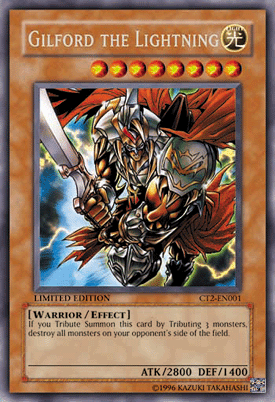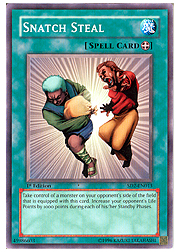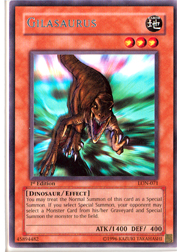“By tributing three monsters, I activate Gilford’s special ability! All of your monsters are goners.”—Joey Wheeler
Behold Sir Gilford, wielder of the Odinson Blade. Few have controlled it and many have feared it. In the hands of evil, it could control the destiny of mankind—but in Gilford’s hands, it swears an oath to justice. As one of Joey’s most powerful monsters, Gilford the Lightning has helped Joey turn the tide of battle when he was facing imminent defeat . . . and it can do the same for you.
Bring Forth the Lightning
We’ll begin by looking at the text of Gilford the Lightning:
“If you Tribute Summon this card by Tributing 3 monsters, destroy all monsters on your opponent’s side of the field.”
 Normally when you tribute summon a level 8 monster, you’d only have to tribute two monsters. If you like, you can still do that to summon Gilford the Lightning, but its effect gives you an alternative. By investing three monsters as tributes for Gilford’s tribute summon, you’ll destroy every monster on your opponent’s side of the field.
Normally when you tribute summon a level 8 monster, you’d only have to tribute two monsters. If you like, you can still do that to summon Gilford the Lightning, but its effect gives you an alternative. By investing three monsters as tributes for Gilford’s tribute summon, you’ll destroy every monster on your opponent’s side of the field.
When you perform the tribute summon, perform it as you normally would by offering monsters as tributes. But instead of just offering two monsters, you’ll offer three. Then, you’ll place Gilford the Lightning onto the field and its effect will activate. This begins a chain, and when that chain resolves, Gilford’s effect will destroy all monsters on your opponent’s side of the field. Remember that this effect only activates when you tribute summon Gilford the Lightning, and only if you tribute three monsters to summon it. The effect will not activate if you set or special summon Gilford or if you tribute summon Gilford normally.
The effect of Gilford is a trigger effect that activates at the time of the tribute summon, but only when you meet the requirement of offering three monsters as a tribute. If the opponent has a card effect in play that also activates when a monster is summoned, the two effects will form a chain. Since it is your turn and you’re the one who’s tribute summoning Gilford the Lightning, your effect is placed on the chain first, and your opponent’s effect is placed on the chain second.
For example, if my opponent has Stumbling active on his or her side of the field, Gilford’s effect will be placed on the chain first, and Stumbling's effect will be second on the chain. This means that my opponent’s effect will resolve first, followed by Gilford’s effect.
Now that we have the basic mechanics out of the way, let’s move on to what really interests us. How do we get Gilford to work?
The Allies of Gilford
Placing three monsters onto the field to offer as tributes for the tribute summon should be your top priority. If you want Gilford to bring forth the lightning, you’re going to need some support.
 Let’s consider the traditional route of using your opponent’s monsters for tributes. By using cards like Snatch Steal and Brain Control, you’ll be able to take away your opponent’s monsters and use them to pay for Gilford’s effect. But using this method is a bit of a waste, because Gilford’s effect already destroys the opponent’s monsters. Let’s look at some alternatives.
Let’s consider the traditional route of using your opponent’s monsters for tributes. By using cards like Snatch Steal and Brain Control, you’ll be able to take away your opponent’s monsters and use them to pay for Gilford’s effect. But using this method is a bit of a waste, because Gilford’s effect already destroys the opponent’s monsters. Let’s look at some alternatives.
Our first ally is Kaiser Sea Horse from Dark Beginning 2. Kaiba’s own monster, used to make his Blue-Eyes White Dragon easier to summon, can help out Gilford as well. Thanks to its effect, it counts as two of the tributes needed for the tribute summon of a Light monster. By offering Kaiser Sea Horse as a tribute for the tribute summon of Gilford the Lightning, you will only need to tribute one additional monster to satisfy Gilford’s effect. Kaiser Sea Horse is tough, but it has a good chance of running into and being defeated by stronger monsters.
Syrus’s monster Gyroid, from Cybernetic Revolution, will protect itself from destruction in battle once during your opponent’s turn. This makes Gyroid more difficult to take down. Then there’s Revival Jam in Dark Beginning 1, which you can special summon back from your graveyard by paying a price when it is destroyed in battle. Last on our list is Spirit Reaper from Dark Revelation 1, a monster that’s well known for protecting itself in battle. While it may not be as strong as Gyroid or Revival Jam, it’s certainly irritating and isn’t likely to go away without your opponent expending resources. Monsters like these work well because they have automatic protection effects that don’t require you to expend any additional resources. Although Revival Jam will cost you life points, it’s often easier to spend life points than it is to spend cards.
We also have monsters that are capable of replacing themselves. Monsters like Shining Angel, Mystic Tomato, and Apprentice Magician give you an even exchange of one-for-one, but some monsters will do even more. Cobra Jar from Dark Revelation 1 can replace itself with a Poisonous Snake token when it’s flipped. If you can keep your opponent from attacking Cobra Jar, you’ll be able to flip summon it, use its effect, and then offer both monsters as tributes. Gravekeeper’s Spy, found in the same expansion, is another strong choice with a solid DEF value.
Both of these monsters are great, but Nimble Momonga and Hyena are even better at swarming. By replacing themselves with two monsters, you’ll speed up the process of getting tribute monsters into play. Combine these elements and you’ll have a strong platform for Gilford’s success.
Anyone who participated in the Cybernetic Revolution Sneak Preview event has access to a trap card that can make things much easier: Embodiment of Apophis. Embodiment of Apophis can be set on the field, lying in wait for the moment you need it as a tribute for Gilford the Lightning. You need only activate it during your main phase and it will place itself into your monster zone, perfect for tributing.
Assemble the Knights!
The previous strategies all focus on a long-term approach. They keep a supply of monsters running until you draw Gilford the Lightning. But what if you draw into Gilford early, and you need to bring forth the lightning in a hurry?
Some monsters can be special summoned right from your hand, allowing you to quickly bring out tribute monsters to herald the arrival of Gilford the Lightning. Cyber Dragon from Cybernetic Revolution will start things off quickly if you have no monsters in play, or you can use The Fiend Megacyber, from Dark Beginning 1, if your opponent is quite ahead of you in monsters.
 These two work well, but both of them are strong monsters that you’d probably rather keep on the field. Gilasaurus provides you with another alternative that should be more to your liking. When you use Gilasaurus’s effect, your opponent special summons a monster from the graveyard, and you’ve essentially given him or her an advantage. This will no longer be the case, because Gilford’s effect will make sure that the opponent’s monster gain is quickly taken away.
These two work well, but both of them are strong monsters that you’d probably rather keep on the field. Gilasaurus provides you with another alternative that should be more to your liking. When you use Gilasaurus’s effect, your opponent special summons a monster from the graveyard, and you’ve essentially given him or her an advantage. This will no longer be the case, because Gilford’s effect will make sure that the opponent’s monster gain is quickly taken away.
To achieve this end, you can also use The Shallow Grave. Normally you’ll encounter the same problem when using The Shallow Grave to special summon a monster from your graveyard, but when Gilford the Lightning’s great power destroys the opponent’s special summoned monsters, it won’t matter any more. Combining The Shallow Grave with Kaiser Sea Horse will really speed things along.
Finally, we have the classic Giant Trunade and Premature Burial combo, which Joey Wheeler used in the recent KC Grand Championship series. While Joey used this combo to bring back Gilford the Lightning from his graveyard, we can use it to bring back monsters to be tributed. Monsters like Kaiser Sea Horse and Sangan will be perfect for this job.
Some deck types have inherent swarm tactics, which makes them great at supporting Gilford the Lightning. The Agent of Creation – Venus from Ancient Sanctuary, with its ability to special summon Mystical Shine Ball from your hand or deck, can easily take you from having no monsters to four monsters within one turn. Three copies of Mystical Shine Ball work well as tributes for Gilford the Lightning, and you can use cards like Backup Soldier to return them to your hand, using The Agent of Creation – Venus’s effect again.
There’s also Dimension Fusion from Invasion of Chaos, another great swarm tactic that relies upon removing monsters in your graveyard from play. With Dimension Fusion and Soul Release, you’ll remove three or more monsters in your graveyard from play and then use Dimension Fusion to bring them back into play. It won’t matter what your opponent brings back, because you’ll just destroy his or her monsters with Gilford the Lightning’s effect! You can also use Return from the Different Dimension, but it can be more costly when it’s used in the early game.
Rise of Destiny introduced a swarm tactic for Machine-type monsters, and that’s Machine Duplication. By using Machine-type monsters with an ATK of 500 or less, you can quickly bring three Machine-type monsters into play in one turn. These Machine-type monsters can then be used as the tributes for Gilford the Lightning. Among your choices are Jinzo #7, which is good for direct attacks, and the useful Machine-Union monster Heavy Mech Support Platform.
How about using low-level monster swarm cards like Enchanting Fitting Room and Human-Wave Tactics? Construct your deck around this strategy and you can easily get three monsters into play for Gilford. Or perhaps you’d be more comfortable with the recursion abilities of the Zombie-type monsters? They have access to the powerful replacing monster Pyramid Turtle, the stalling might of Spirit Reaper, and the self-reviving powers of the Vampire Lord. They also have Book of Life, one of the best revival cards in the game, and you can even run three copies of it in your deck!
There are many approaches that you can take to bring Gilford the Lightning into play, but the goal is always the same: destroy your opponent’s monsters and take control of the duel.
Send all comments to Curtis@Metagame.com.